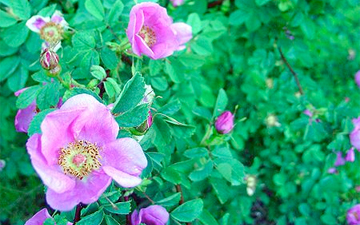Rosa nutkana (Nootka Rose, Bristly rose,[3] Wild rose[4]) is a 2-10 foot (60cm-3m) tall perennial shrub in the Rose family (Rosaceae).[5] It has light green paired leaflets with toothed edges and sharp spines on the bottom. The 2-3 inch pink (5-8cm) flowers usually occur singly, but may appear in groups of 2 or 3. The flowers, which appear in early summer, can have a pleasantly strong fragrance. The fruits (hips) of Nootka rose are somewhat bitter but edible. It is reported that freezing and thawing will greatly mitigate the bitterness and make the hips much more palatable. This plant is native to Western North America where it grows in moist openings and less often on open hillsides.[4] Nootka rose serves as the larval host of the Mourning Cloak and Grey Hairstreak butterflies.[5]
Rosa nutkana was used medicinally by a great number of Indigenous Peoples to treat a wide variety of ailments, and also ceremonially, in handcrafts, and as a food source.[6]
The species name nootka comes from the Nootka Sound of Vancouver Island, where the plant was first described.[7]
(From Wikipedia, April 23, 2010)





